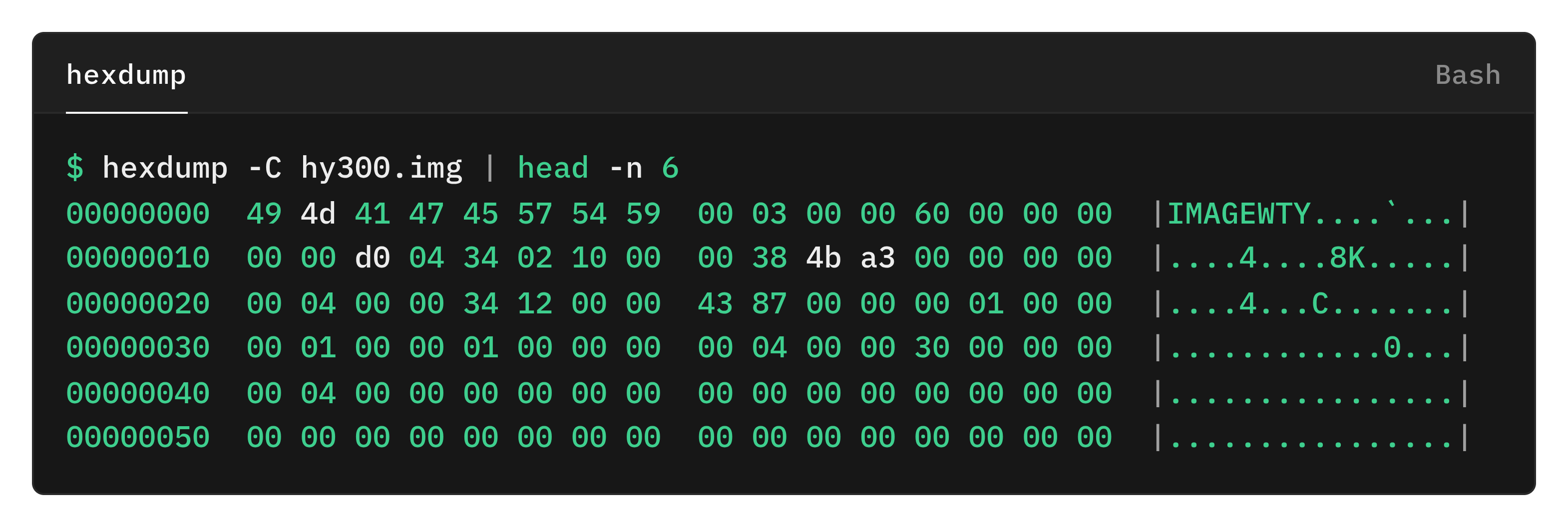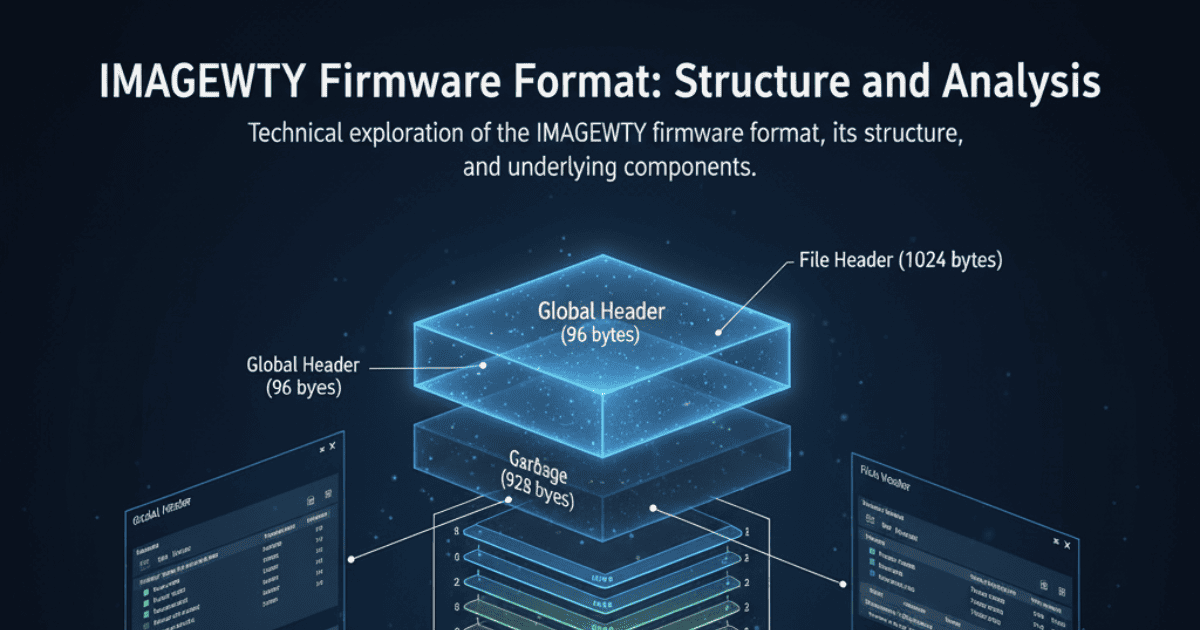The IMAGEWTY format is used by the LiveSuit, PhoenixSuit, PhoenixUSB, and PhoenixCard tools, all of which are closed-source, as are their protocols and standards.
Extraction and Repacking Tools
imgRePacker (Windows) Worked only on Windows, despite having a Linux version. Failed to process images with header
0x403.imagewty-tool (Linux) Functional and still under development. Successfully tested with images having headers
0x300and0x403.AWUtils (Linux) Outdated, and extraction did not work as expected (bugs).
Basic Structure
The basic layout of an IMAGEWTY format image can be represented as follows:
This structure allows creating a valid image even without the random (garbage) data present in traditional images. In a hexadecimal view, additional data of unknown purpose can be observed.
+------------------------------+
| Global Header (96 bytes) |
+------------------------------+
| Garbage / Unused (928 bytes) |
+------------------------------+
| File Header #1 (1024 bytes) |
+------------------------------+
| File Header #2 (1024 bytes) |
+------------------------------+
| File Header #3 (1024 bytes) |
+------------------------------+
| ... |
+------------------------------+
| File Header #48 (1024 bytes) |
+------------------------------+
| |
| File Data #1 |
| (size varies) |
| |
+------------------------------+
| |
| File Data #2 |
| (size varies) |
| |
+------------------------------+
| ... |
+------------------------------+
| |
| File Data #48 |
| (size varies) |
| |
+------------------------------+
The image consists of a global header, followed by individual file headers, and finally the files themselves.
In the example, the illustration contains 48 files, each with its respective header.
Global Header
Although the header is 96 bytes, only 68 bytes are actually used. The structure is as follows:
+---------+-----------+----------------------------------------+
| Offset | Size | Field / Description |
+---------+-----------+----------------------------------------+
| 0x00 | 8 bytes | Magic / Signature ("IMAGEWTY") |
| 0x08 | 4 bytes | Header Version |
| 0x0C | 4 bytes | Header Size |
| 0x10 | 4 bytes | Base RAM |
| 0x14 | 4 bytes | Format Version |
| 0x18 | 4 bytes | Total Image Size (compressed) |
| 0x1C | 4 bytes | Header Size Including Alignment |
| 0x20 | 4 bytes | File Header Length |
| 0x24 | 4 bytes | USB Product ID |
| 0x28 | 4 bytes | USB Vendor ID |
| 0x2C | 4 bytes | Hardware ID |
| 0x30 | 4 bytes | Firmware ID |
| 0x34 | 4 bytes | Unknown Field #1 |
| 0x38 | 4 bytes | Unknown Field #2 |
| 0x3C | 4 bytes | Number of Files in Archive |
| 0x40 | 4 bytes | Unknown Field #3 |
| 0x44… | padding | Zeros to align to Header Size (96 B) |
+---------+-----------+----------------------------------------+
The header starts with the 8-byte signature “IMAGEWTY”. The remaining fields are stored in 4-byte blocks, totaling 68 bytes of actual data. The 28 extra bytes and the 928-byte garbage area can be filled with zeros.

Offset: from 0x000 to 0x3FF — includes 96 bytes of header and 928 bytes of garbage, totaling 1024 bytes.
After this, the file headers begin at offset 0x400.
Expected Values
Values present in the global header of the example image:
Magic / Signature = "IMAGEWTY"
Header Version = 0x300 (v3)
Header Size = 0x60 (96 Bytes)
Base RAM = 0x4D00000
Format Version = 0x100234
Total Size = 0xA34B3800 (2,612.70 MB)
Header + Alignment = 0x0 (0)
File Header Length = 0x400 (1024 Bytes)
USB Product ID = 0x1234
USB Vendor ID = 0x8743
Hardware ID = 0x100
Firmware ID = 0x100
Unknown Field #1 = 0x1 (1)
Unknown Field #2 = 0x400 (1024)
Number of Files = 0x30 (48)
Unknown Field #3 = 0x400 (1024)
Since the file is little-endian, the data may appear differently when viewed in hexadecimal.
- Header Size → size of the global header
- File Header Length → size of each file header
- Number of Files → total number of files in the image
File Headers
The first file header starts at the fixed offset 0x400, immediately after the 1024-byte global header including garbage.
All files follow the same header structure, with most values changing only minimally:
+------------+--------+----------------------+
| Offset | Size | Field |
+------------+--------+----------------------+
| 0x400 | 4 B | Filename Length |
| 0x404 | 4 B | Header Size |
| 0x408 | 8 B | Maintype |
| 0x410 | 16 B | Subtype |
| 0x420 | 4 B | Unknown0 |
| 0x424 | 256 B | Filename |
| 0x524 | 4 B | Stored Length |
| 0x528 | 4 B | Pad #1 |
| 0x52C | 4 B | Original Length |
| 0x530 | 4 B | Pad #2 |
| 0x534 | 4 B | File Offset |
| 0x538-0x7FF| 456 B | Garbage / Padding |
+------------+--------+----------------------+
- Filename Length → length of the filename
- Header Size → size of this file header (typically 1024 bytes)
- Maintype → main type (e.g.,
"COMMON") - Subtype → subtype (e.g.,
"BOARD_CONFIG_BIN") - Filename → file name, null-padded (e.g.,
boot.fex) - Stored Length → stored file size (with padding)
- Original Length → actual file size (without padding)
- File Offset → starting position of the file data
Expected Values (example: sys_config.fex)
Filename Length = 0x100 (256)
File Header Size = 0x400 (1024)
Maintype = "COMMON "
Subtype = "SYS_CONFIG100000"
Unknown = 0x0 (0)
Filename = "sys_config.fex"
Stored Length = 0x800 (2048)
Pad #1 = 0x0 (0)
File Length = 0x7BF (1983)
Pad #2 = 0x0 (0)
File Offset = 0xD800 (55296)
- Stored Length → file size including padding
- File Length → actual file size without padding
- File Offset → starting position of the file inside the image
Garbage-filled file header
Overview
In the tests I conducted, images generated with imagewty-tool and flashed with PhoenixSuit did not show any errors.
+------------------------------+
| Global Header (96 bytes) |
+------------------------------+
| Garbage / Unused (928 bytes) |
+------------------------------+
| File Header #1 (1024 bytes) | <- starts at offset 0x400
+------------------------------+
| File Header #2 (1024 bytes) |
+------------------------------+
| File Header #3 (1024 bytes) |
+------------------------------+
| ... |
+------------------------------+
| File Header #48 (1024 bytes) |
+------------------------------+
| |
| File Data #1 |
| (size varies) |
| |
+------------------------------+
| |
| File Data #2 |
| (size varies) |
| |
+------------------------------+
| ... |
+------------------------------+
| |
| File Data #48 |
| (size varies) |
| |
+------------------------------+
For now, I recommend reading:
- Structure of the Android firmware image: http://nskhuman.ru/allwinner/firmware.php?np=1 imagewty-tool and these posts are based on the “Structure of the Android firmware image”.
May also be useful:
- Purpose of files in the firmware image: http://nskhuman.ru/allwinner/firmware.php?np=2
- Partitions: How the sections are used: http://nskhuman.ru/allwinner/firmware.php?np=4
- GPT Partition Table: http://nskhuman.ru/allwinner/firmware.php?np=3
Next post
In the next post, I will cover the files extracted from the image and how to modify them, such as boot.fex and super.fex.
$ lsarisc.fex dlinfo.fex sys_config.fex Vboot-resource.fex
aultls32.fex dtbo.fex sys_partition.fex Vdtbo.fex
aultools.fex env.fex toc0.fex vendor_boot.fex
board.fex fes1.fex toc1.fex Venv.fex
boot0_nand.fex misc.fex u-boot-crash.fex Vmisc.fex
boot0_sdcard.fex Reserve0.fex u-boot.fex vmlinux.fex
boot.fex split_xxxx.fex usbtool_crash.fex VReserve0.fex
boot_package.fex sunxi.fex usbtool.fex Vsuper.fex
boot-resource.fex sunxi_gpt.fex vbmeta.fex Vvbmeta.fex
cardscript.fex sunxi_mbr.fex vbmeta_system.fex Vvbmeta_system.fex
cardtool.fex sunxi_version.fex vbmeta_vendor.fex Vvbmeta_vendor.fex
config.fex super.fex Vboot.fex Vvendor_boot.fex
